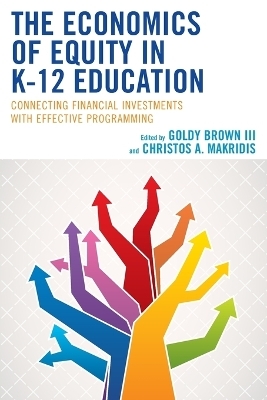
The Economics of Equity in K-12 Education
Rowman & Littlefield (Verlag)
978-1-5381-6899-8 (ISBN)
This book informs the American Education Stakeholders about the importance of empowering our learners with new knowledge, skills, and ability to help them become more effective and influential in society. The United States ranks 25th on the list of OECD countries in its overall poverty gap between people in poverty and affluent people, and ranks 26th in its poverty gap for children born into poverty and children from affluent families. Considering new educational funding measures at the federal, state, and local levels, the American educational system must focus on implementing programs that equip children with multidimensional human capital that enables them to be upwardly mobile, particularly in an era of intense technological change with the expansion of automation and artificial intelligence. These goals are not new. We believe that now is an important time to articulate and commit to the transmission of human capital for children and identify the practices that best promote it.
This book aims to make recommendations to educational programming that should be invested in that has shown potential in mitigating the opportunity gap and increasing human capital. With long aftershocks, the pandemic’s dramatically decreased educational opportunities may mean that America’s future workforce will be devastated by the declining number of children in our pre-K-12 system, a phenomenon predicted to begin showing its effects in 2025, with a higher number of students projected to be below grade level in skilled areas. Simply increasing funding will have little impact in driving improved outcomes if the funds are not used wisely; indeed, expenditures per student have roughly tripled since 1960.
This book recommends a systems-level approach to the American education system. The authors believe that without deeply considering the underlying incentives and governance of educational programming initiatives, more money alone will not solve the skills gap and declining out comes among learners. This handbook will be essential to state and local entities to make systemic recommendations to practitioners, college professors, and researchers.
Goldy Brown III is an Assistant Professor and the Director of Whitworth University's Education Administration Program. He has served as a former professor and routine guest speaker in college courses, where he has gained valuable experience leading college level discussions on educational foundations and leadership. In addition, he has conducted seminars on “what principals look for when hiring a teacher.” He also has seven years of experience as a K-12 leader, serving as a principal. Schools that he led received four state recognition awards for closing the achievement gap between low-income and affluent students. Dr. Brown has also published articles on school leadership. His research focuses on Leading for traditionally underserved students and effective educational programming & policy for traditionally underserved students. Christos A. Makridis serves as a Research Professor at the W. P. Carey School of Business in Arizona State University, a Digital Fellow at the Digital Economy Lab in Stanford University, a Non-resident Fellow at the Institute for Religious Studies at Baylor University, a Senior Adviser at Gallup, and a Senior Adviser on the National Artificial Intelligence Institute at the Department of Veterans Affairs. Christos previously served on the White House Council of Economic Advisers managing the cybersecurity, technology, and space activities, as a Non-resident Fellow at the Cyber Security Project in the Harvard Kennedy School of Government, as a Digital Fellow at the Initiative at the Digital Economy in the MIT Sloan School of Management, and as a Visiting Fellow at the Foundation for Defense of Democracies. Christos earned a Bachelor’s in Economics and Minor in Mathematics at Arizona State University, as well a dual Masters and PhDs in Economics and Management Science & Engineering at Stanford University. https://www.christosmakridis.com/
Introduction
Section I: Educational Programs that have Produced Some Positive Results
Chapter 1: The Economic Value of Parent and Community Involvement
(Albert A. Cheng & Bob Maranto)
Changing Family Structure, Schools, and Society
School and Family Inputs
The Education Production Function
The Coleman Report
Waning Attention to Family Inputs
Waxing Attention Paid School Finance
Family Inputs and Children’s Outcomes
Sociology Research and Evidence
Evidence from the Understanding American Study
Educational Research on Parent Involvement and Community Engagement
Evaluations of Family Support Interventions
Implications for Policy and Practice and Future Research
Chapter 2: Social Emotional Learning in Pre-K-12 Schools
(Mark Brackett, Nicole Elbertson, Tangular A. Irby, & Krista L. Smith)
RULER as a Case Study
Best Practices in Equitable Implementation of SEL
Commit to Making Equitable SEL a Priority
Hire and Maintain a Diverse Staff to Instruct and Model SEL
Get to Know Students to Ensure Lessons and Examples are Relevant and Meaningful
Acknowledge Ethnocentrism and Bias in SEL Programs and Practices and Correct for Them
Ensure SEL is Not Misused to Control Marginalized Groups
Choose Words Carefully
Ensure Accessibility of All Tools, Strategies, and Content
Consider Using SEL as a Means to Transform Inequitable Settings and Systems
Partner with Parents, Caregivers, and the Community
Be Curious and Open to Feedback
Use SEL for Prevention as Well as Intervention
Monitor All SEL Efforts Over Time and Strive for Continuous Improvement
Conclusion and Policy Implications
Chapter 3: Quality and Intentionality: Making Afterschool Programs More Effective
(Goldy Brown III)
Taxonomy of Government-Funded Afterschool Interventions
Academic Improvement
Social Emotional Learning
Exposure, Recreation, and STEM
Improving Afterschool Programs: Quality & Intentionality
Implementation Questions and Recommendations
Recommendations for Programming
Personnel and Attendance
Funding
Potential Cost-Effective Analysis
Preventing Negative Behavior
Further Research Regarding Afterschool Programming
Chapter 4: Career, Technical, & Higher Education Opportunities for Traditionally Underserved Students
(Walter Ecton)
Background and Evidence on CTE Outcomes
Vocational Education in the International Context
Examining CTE in Today’s Context
Data
Descriptive Findings
Methods
Results and Discussion
Recommendations for Policy and Practice
Define Intended Outcomes for Specific CTE Programs
Build Partnerships to Strengthen CTE Programs
Only Offer High-Quality, Relevant CTE Programs
Ensure Access to CTE for the Students Who Stand to Benefit Most
Focus on Equitable Participation in CTE
Opportunities for Future Research and Questions for Policymakers
Chapter 5: Turning Hurdles into Launch Pads: Improving Equity and Efficiency through Increased High School Graduations in the United States
(Aidan Vining & David Weimer)
Available Evidence on Ethnicity/Race (Minority) and Income Differences
Why Does It Matter? The Social Value of High School Completion
High School Graduation Shadow Prices for the United States
Estimation Steps
Estimation Issues
Shadow Price Estimates
Benefits and Discount Rates
Benefits Including Externalities
Applicability of the Estimates to Minority and Economically Disadvantaged Students
Increasing Minority and Disadvantaged Student Graduation
CBA and CEA Evidence
Promising Interventions that Have Not (Yet) Been Shown to Offer Positive Net Benefits
Conclusions and Policy Implications
Section II: Changes Needed at the State and Local Level to Make Positive Results More Widespread
Chapter 6: Getting Past the Current Trade-Off Between Privacy and Equity in Educational Technology
(Ryan Baker)
The Promise of Artificially Intelligent Educational Technology
The Risk of Algorithmic Bias
The Push Towards Prioritizing Privacy
Alternative Ways to Protect Privacy While Improving Algorithmic Effectiveness
Recommendations for State Educational Agencies and School Districts
Provide Demographic Data to Vendors for the Purpose of Checking for Algorithmic Bias
Incentivize Vendors to Conduct Algorithmic Bias Audits, or Conduct them Directly
Rather than Asking Vendors to Delete Data, Ask them to Secure it
Encourage Vendors to Adopt Data Infrastructures that Enable Privacy-Protecting Analyses
Conclusions
Chapter 7: Identifying, Establishing, and Distributing the Economic Value of the Classroom Teacher
Matthew Springer & Christopher Brooks
Quantifying the Economic Value of Teachers
Maximizing Teacher Value: Policy Reforms to Compensation, Recruitment, Evaluation, and Retention
The Problem: Teacher Compensation Policies Fail to Recognize the Value of Teachers
Potential Policies for Improvement: Teacher Performance Incentives
Challenges in Evaluating and Retaining the Most Effective and Valuable Teachers
The Problem: Teacher Evaluation Systems Neither Adequately Differentiate Teachers by Ability Nor Emphasize the Economic Value of Teachers
The Solution: Evaluation Systems that Emphasize Robust Measures of Value-Added
The Problem: Teacher Retention is Low, Especially for Highly Effective Teachers, and School Leaders Have Limited Capacity for Removing Ineffective Teachers
Potential Policies for Improvement: Tenure Reforms, Principal Accountability, and Increased Incentives
Equity: How Can We Get the Most Effective Teachers to Work with the Least Advantaged Students
Conclusion and Recommendations
Compensation
Evaluation
Retention
Distribution
Chapter 8: Effective School Choice Systems in a State (Corey DeAngelis)
Politicization of Public School COVID-19 Responses
Incentives in the Governance of Public and Private Schools
Empowering Families and Improving Outcomes
Understanding the Incentives Behind Funding Students, Not Systems
Implementable State Policy Recommendations
K-12 Education’s New Special Interest
Chapter 9: The Economic Value of Expanding Effective Systemic School Changes that raise the achievement of Low-Income Students (F. Mike Miles)
Ignoring System Principles
A Different System
Key Obstacles to Systemic Change
The Navarré Point
Other Obstacles
Constraints of an Interconnected System
Status Quo Bias
Risk Aversion
Failure to Assess the Future
How to Change the System
Eight Principles of a New Education System
Learning Happens Everywhere and Anytime
Learning is Personalized and Students Own their Learning
Parents have Access to an Expanded Number of Choices of Schools and Programs
The System Offers a New Employee Value Proposition and Compensation is Tied to what the System Values Most
Learning is Increasingly Focused on How to Think and How to Learn
The School, Community, and Family Provide Students with a Set of Required Experiences, Not Just Specific Courses
Community Groups are Tapped to Educate Students in Many Non-Core Subjects
Governing Entities Check and Balance one another and Encourage Innovation
At the Operational Level
A Focus on Outcomes
Alignment Throughout the Organization
Accountability
Support
Progress Monitoring
Budget Priorities
Compensation and Incentives
Capacity
Leadership Density
System Principles
Vision for the Future
The Pace of Change
Adaptability
A Model for Systemic Reform
The Pace of Change
Reimagined Schools?
About the Contributors
References
| Erscheinungsdatum | 20.01.2023 |
|---|---|
| Verlagsort | Lanham, MD |
| Sprache | englisch |
| Maße | 154 x 224 mm |
| Gewicht | 372 g |
| Themenwelt | Sozialwissenschaften ► Pädagogik |
| Sozialwissenschaften ► Politik / Verwaltung ► Staat / Verwaltung | |
| Wirtschaft ► Betriebswirtschaft / Management ► Allgemeines / Lexika | |
| Wirtschaft ► Betriebswirtschaft / Management ► Unternehmensführung / Management | |
| Wirtschaft ► Volkswirtschaftslehre ► Wirtschaftspolitik | |
| ISBN-10 | 1-5381-6899-5 / 1538168995 |
| ISBN-13 | 978-1-5381-6899-8 / 9781538168998 |
| Zustand | Neuware |
| Informationen gemäß Produktsicherheitsverordnung (GPSR) | |
| Haben Sie eine Frage zum Produkt? |
aus dem Bereich


